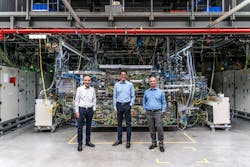ZEISS, TRUMPF, and Fraunhofer IOF awarded German Future Prize 2020
German Federal President Frank-Walter Steinmeier announced the winners of the German Future Prize 2020 (Deutscher Zukunftspreis 2020) in a ceremony in Berlin, Germany held November 25, 2020. The Federal President honored the team made up of Peter Kürz from ZEISS Semiconductor Manufacturing Technology (SMT; Oberkochen, Germany) segment, Michael Kösters from TRUMPF Lasersystems for Semiconductor Manufacturing (Ditzingen, Germany), and Sergiy Yulin from the Fraunhofer Institute for Applied Optics and Precision Engineering (Fraunhofer IOF; Jena, Germany), bestowing on them his technology and innovation award for their project titled “EUV Lithography – New Light for the Digital Age.”
The winning team made a significant contribution to developing extreme-ultraviolet (EUV) technology and preparing it for industrial series production. This resulted in future-proof technology backed by more than 2000 patents, forming the basis for the digitalization of everyday life and enabling applications such as automated driving, 5G, artificial intelligence (AI), and other future innovations. Thanks to EUV, over 3300 high-tech jobs have been created at ZEISS and TRUMPF to date and an annual turnover of more than one billion euros—with an upward trend—was generated in 2019.
ASML (Eindhoven, Netherlands) is the world's only EUV lithography machine manufacturer. As an integrator, the company designed the overall system architecture and the EUV source in particular. The high-power laser from TRUMPF for the EUV light source and the optical system from ZEISS are key components of these machines. This key technology can be used to produce significantly higher-performance and more energy-efficient and cost-effective microchips. The manufacturing process for the latest chip generations is based on the use of EUV light, pushing the limits of what is technologically feasible.
With the world's strongest pulsed industrial laser, TRUMPF supplies a key component for the exposure of the most modern microchips used in every modern smartphone. There is no economical alternative to this laser for generating the light required for EUV lithography. The quality and form of the illumination system and the resolution power of the projection optics from ZEISS determine how small the structures on microchips can be. The mirrors used in the optical system therefore contain significant innovations. Since even the smallest irregularities lead to imaging errors, the world's “most precise” mirror was developed for EUV lithography. Fraunhofer IOF was an important research partner in the sophisticated coating technology for the large-scale mirrors.
The Deutsche Zukunftspreis, which has been presented every year since 1997, is one of the highest accolades for scientific achievement in Germany and is worth 250,000 euros. It honors exceptional achievements in technology, engineering, and the life sciences that have resulted in viable products. Every year, during a multistage selection process, the prestigious jury selects three research teams and their innovation for the final round from among a large number of different projects. Alongside their innovative achievements, the jury also evaluates the development's economic and social potential.
